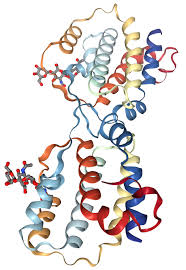อินเตอร์ลิวคิน-34 (IL-34) เป็นไซโตไคน์ที่ได้รับความสนใจอย่างมากในช่วงไม่กี่ปีที่ผ่านมาเนื่องจากมีบทบาทที่น่าสนใจในการควบคุมภูมิคุ้มกัน ในโพสต์บล็อกนี้ เราจะเจาะลึกเข้าไปในโลกที่น่าสนใจของ IL-34 สำรวจหน้าที่ของ IL-34 ผลกระทบต่อสุขภาพและโรค และข้อมูลเชิงลึกจากการวิจัยล่าสุด ทำความเข้าใจอินเตอร์ลิวคิน-34IL-34 เป็นไซโตไคน์ที่จับกับตัวรับโคโลนีสติมูเลติ้งแฟกเตอร์-1 (CSF-1R) ซึ่งมีบทบาทสำคัญในการพัฒนาและการทำงานของแมคโครฟาจและเซลล์ไมอีลอยด์อื่นๆ ซึ่งแตกต่างจากโคโลนีสติมูเลติ้งแฟกเตอร์-1 (CSF-1) IL-34 ทำงานผ่านเส้นทางที่แตกต่างกัน ทำให้การปรับระบบภูมิคุ้มกันมีความซับซ้อนมากขึ้น หน้าที่และผลกระทบ การวิจัยระบุว่า IL-34 มีส่วนสนับสนุนกระบวนการทางสรีรวิทยาต่างๆ รวมถึง:
Macrophage Differentiation: IL-34 promotes the differentiation of monocytes into macrophages, influencing tissue homeostasis and immune responses.Microglial Activation: In the central nervous system, IL-34 is involved in microglial activation and neuroinflammation, highlighting its role beyond traditional immune functions.Bone Metabolism: IL-34 regulates osteoclast differentiation and bone remodeling, linking it to skeletal health and diseases like osteoporosis.Skin Homeostasis: Studies suggest IL-34’s involvement in skin physiology, influencing the behavior of dermal macrophages and skin immune responses.Implications in Health and DiseaseThe multifaceted functions of IL-34 have significant implications in various health conditions and diseases:
Inflammatory Disorders: Dysregulated IL-34 expression is associated with inflammatory diseases such as rheumatoid arthritis, inflammatory bowel disease, and psoriasis.Neurological Conditions: IL-34’s role in microglial activation has implications for neurodegenerative disorders like Alzheimer’s disease and multiple sclerosis.Cancer Biology: Emerging research explores IL-34’s impact on tumor-associated macrophages and its potential as a therapeutic target in cancer immunotherapy.Latest Research and Future DirectionsRecent studies continue to unravel the complexities of IL-34 biology, offering insights into its therapeutic potential and clinical applications. Future research directions include:
Targeted Therapies: Investigating IL-34 inhibitors and agonists for targeted immune modulation in inflammatory diseases and cancer.Diagnostic Biomarker: Exploring IL-34 as a diagnostic biomarker for assessing disease severity and treatment response in immune-related disorders.Tissue-Specific Effects: Understanding IL-34’s tissue-specific effects and signaling pathways for tailored therapeutic interventions.ConclusionInterleukin-34’s intricate involvement in immune regulation, tissue homeostasis, and disease pathogenesis underscores its significance as a promising target in biomedical research and clinical medicine. As our understanding deepens, IL-34 holds potential for innovative therapies and diagnostic strategies, paving the way for advancements in immunology and personalized medicine.


